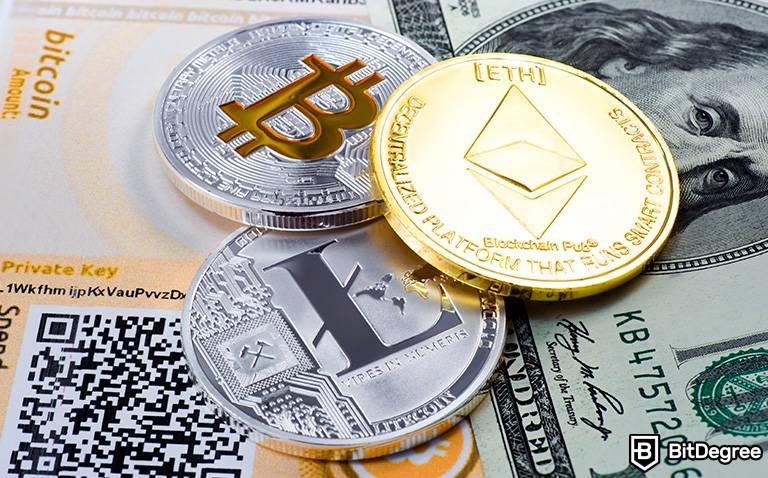Free Airdrop Season 7 is LIVE! Answer fun questions or do simple tasks to earn rewards from the $30K BitDegree prize pool. Participate Now ! 🔥
Whether you're just dipping your toes in the crypto space for the first time or already have some trading experience under your belt, there's one thing you can probably agree with – there are a lot of new terms and concepts to learn. The one we'll be looking at today will answer an important question – what is fiat in crypto?
Throughout this article, we'll cover a broad range of aspects you need to know about fiat. First, we'll define what fiat means and where the term comes from. Then we'll take a look at some of the key fiat vs crypto differences. Finally, we'll get more practical and see how converting crypto to fiat on Binance works.
There's a lot to cover, from the basics of fiat to crypto trading practices, so we won't be able to analyze everything in-depth. However, if you come across any term you want to learn more about, chances are you'll find it in our Crypto Handbook.
Without further ado, let's find out what the crypto fiat meaning is.

Did you know?
Subscribe - We publish new crypto explainer videos every week!
What is Odysee & LBRY? Is Decentralized YouTube Possible? (ANIMATED)


Table of Contents
What is Fiat in Crypto?
First, let's get the obvious out of the way – we're not talking about the car brand here. You can use fiat to buy a Fiat, but that's as far as it gets. So, what is fiat in crypto, then? Well, when we're talking about it in this context, we mean currencies.
Latest Deal Active Right Now:Head to BitDegree Missions, gather as many Bits as possible & claim your stake of the $30,000 Prize Pool! Don't waste your time & start collecting Bits by completing Missions and referring friends.
Fiat refers to a currency not backed by a commodity like silver, gold, or platinum. Instead, its value is set by the government that issues it and the people that use it. Since they're regulated and authorized by governments, fiat currencies are typically considered legal tender – think the US dollar, the euro, the Mexican peso, and so on.
The term "fiat" means "let it be done" or "may it happen". Essentially, this refers to how fiat currencies are permitted by governing bodies to be used in a legal sense. Although the term we use nowadays comes from Latin, the first fiat currencies were used in China back in the 11th century.

Let's jump a few hundred years ahead to the previous century. After the Second World War, the value of the US dollar was pegged to one troy ounce of gold, technically making it commodity money.
However, over the years, the decision to peg the dollar to gold drew more and more criticism. In 1971, US President Richard Nixon introduced a new policy that suspended the dollar's convertibility to gold, eventually leading to the use of freely floating fiat currencies spreading worldwide.
Getting back to the current day, we still have to answer our main question – what is fiat in crypto? Fiat currencies are used to display the value of digital currencies. For example, the BitDegree Cryptocurrency Tracker allows you to choose from over 90 fiat currencies to see the current crypto prices.

There are two terms you might come across often if you're trading crypto – fiat on-ramp and fiat off-ramp. The process of converting crypto to fiat is known as fiat off-ramp. Off-ramp can also mean exchanging crypto for other goods and services. On the other hand, if you want to turn your fiat to crypto, you'll use the fiat on-ramp method.
As the main basis of the global economy, fiat has an important role to play in the blockchain-based financial sphere. With the general crypto fiat meaning out of the way, we can start asking more specific questions – like why do we need crypto if fiat is so widely used? What sets them apart?
Fiat vs Crypto – Key Differences and Similarities
Now that we've established the basics of what fiat is in crypto, let's take a deeper dive into its context. Since crypto is often described as an alternative to fiat money, there are obviously some differences between the two. But what are they exactly?
To figure out what sets fiat vs crypto apart, we're going to compare several aspects that are tied to the currencies – their physical or digital form, government regulations, security, market volatility, and ways you can store and utilize them.
Physical/Digital Format
One of the key characteristics of fiat money is that it can be both physical and digital. You might not even give it much thought – you can just make your way to any ATM and return with cash. The most standard way of handling fiat currencies is paper money; however, you can also use metal coins or banking cards.

Cryptocurrencies, on the other hand, are pretty much exclusively digital and can only be bought and accessed online, typically on blockchain-based platforms. In some cases, you might be able to get your hands on physical assets like the Casascius Coin. However, they're usually seen as collectors' items.
In recent years, some governments have started discussing the development of central bank digital currencies (CBDCs). They are fiat currencies that can be built and used digitally, similar to cryptocurrencies. However, comparing fiat to crypto, they'd be subject to different regulations (that's something we'll discuss in the next section).
The concept of CBDCs was inspired by cryptocurrencies, although their intent and utility might be somewhat different. A digital US dollar would hold the same value as the banknote.
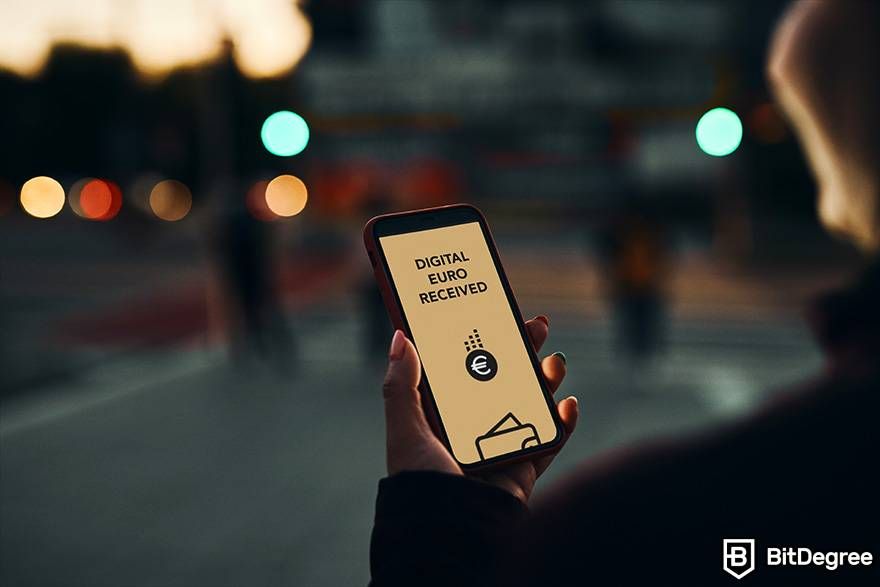
Many CBDC projects are still in the early stages of development, but they might end up being the future answer to what is fiat in crypto – especially ones that might be built on blockchains.
Developments on increasing the accessibility of crypto are also underway. Companies like Binance are introducing debit cards that can be used worldwide and automatically convert crypto to fiat upon transactions.
Regulations and Distribution
We've briefly mentioned regulations. This is one of the core principles that come up when you discuss fiat vs crypto. It emphasizes the differences between centralized fiat currencies and decentralized crypto assets.
Fiat acts as legal tender. This status derives from the fact that the currencies are issued by governments. In the US, fiat currencies are an example of the Full Faith and Credit principle. It means that their value is backed not by a commodity but by the belief of the power that issues the currency.

Typically, fiat currencies are printed by a central bank and then distributed across a range of commercial banks, which in turn grant access to citizens to acquire these assets. It's then used on international, national, and personal levels to buy goods and services, pay debts, and enable other monetary transactions.
As such, institutions like financial ministries and other similar legal entities set laws, regulations, and restrictions around fiat assets to ensure their integrity and validity. These may include printing and distribution, as well as anti-money laundering (AML) policies.
When it comes to cryptocurrencies, many are built on blockchains that are managed by decentralized autonomous organizations (DAOs). Typically, a DAO is the blockchain community itself. The specifics might vary, but usually, to become a DAO member, you need to hold the native tokens of the blockchain.

DAOs enact the key principles of decentralization – crypto assets are not managed by centralized authorities but by users themselves. Often, blockchain communities vote on inner regulations, like the total token supply or its utility.
While fiat is distributed via centralized organizations, blockchain users can buy crypto assets without any intermediaries. In fact, they can use fiat-to-crypto purchase options that transfer their newly acquired assets directly to their accounts or wallets (but more on that later).
As crypto emerges in more fields, the centralized institutions that regulate fiat are also implementing policies for digital assets. For example, in 2018, the EU published the 5th Anti-Money Laundering Directive (AMLD5), which introduced requirements for cryptocurrencies for the first time.

Other regulations regarding the use and AML policies on crypto have been introduced in countries like India, China, and the US. While some countries ban cryptocurrencies outright, others aim to standardize their use. In 2021, El Salvador became the first country to declare Bitcoin as legal tender.
Anti-money laundering policies are mainly targeted at preventing illegal usage of crypto. There are some disputes as to whether some regulations should be maintained for crypto assets. If CBDCs become more popular, more questions about what is fiat in crypto regulated like might arise.
Volatility
Volatility refers to how frequently the price of an asset changes. This aspect can go hand in hand with regulations; however, it's also influenced by market conditions and external factors.
Comparing crypto to fiat, the former is more notorious for experiencing this phenomenon. For one, this is due to the significant difference in how long the two types of assets have been around. Fiat has been established for many years, while crypto started emerging only in the past decade.
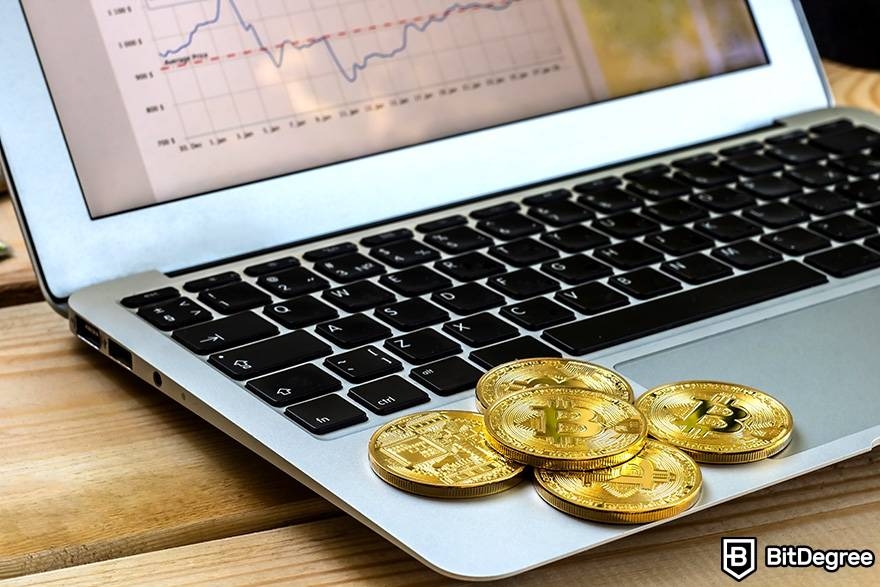
Since crypto is relatively novel and the technology changes almost daily, many shiny new things pop up that catch the investors' eyes for a short while before they move on to the next thing, leading to sudden price spikes and falls. This can make converting crypto to fiat tricky, as you need to find the perfect timing.
Another unique volatility factor when comparing is social media attention. While statements made by government officials regarding the national or global economy can impact the markets, a tweet by an influencer about a relatively unknown altcoin is a different kind of beast that can flip the crypto market in an instant.
From the technical side of things, many cryptocurrencies, especially those based on Bitcoin's model, are deflationary, meaning that their supply is limited. In theory, as the supply diminishes, the price is expected to increase steadily. However, practice has shown that there are more ways than one to impact the price of crypto.
The amount of fiat currency in circulation is determined by the central banking institution, as it's responsible for the printing and supply management. In general, fiat assets are known to be somewhat inflationary, as the printing process can be regulated but can be technically done without limits.
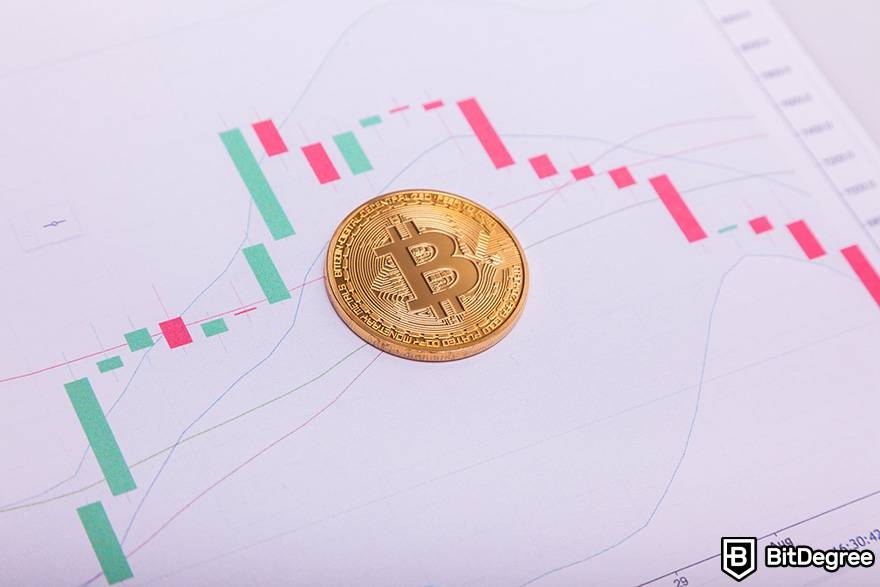
That being said, maintaining a level of inflation can impact the volatility of fiat assets and even lead to a phenomenon known as hyperinflation. If too much money is printed, it starts losing its communal value, affecting the price stability, and negatively impacting the economy as a whole.
Similarly, not all cryptocurrencies are known for high volatility. In fact, some are quite closely related to fiat currencies. These assets are known as stablecoins, and they're often what people have in mind when they define the crypto fiat meaning. There are three main types of stablecoins:
- Algorithmic – these stablecoins are stabilized using algorithms. If the price starts straying from its peg, the algorithm adjusts it accordingly;
- Collateralized – stablecoins that are collateralized by assets in the real world. This type of stablecoin is the equivalent of what is fiat in the crypto space, as the legal tender or commodities that are used to back its value are kept in licensed reserves;
- Fractional – a combination of collateralized and algorithmic stablecoins. Part of the value is backed by assets in reserves, meaning that the redeemable value can't exceed the amount of stablecoins minted. However, an algorithm is also used to keep the price stabilized.
Some stablecoins have their value tied to commodities like gold or silver, while others are pegged to fiat currencies or even other crypto assets. So, in a way, you can differentiate between what is fiat in crypto and what is based on other commodities, similar to how these monetary instruments vary in traditional economies.
If you're not dealing with stablecoins, though, converting crypto to fiat or vice versa can be tricky. Price predictions aren't always accurate, and market trends can change in a matter of minutes. Some traders convert as soon as the price seems convenient, while others tend to hold (or hodl, as it's known in the crypto space).
Security
No matter how large your savings are, you want to make sure that they're kept secure. Some measures taken by both traditional and crypto issuers are similar, like the use of auditors. However, the security risks that fiat vs crypto storages face can be very different.
With fiat reserves, the threats can be against both the cash assets and the ones that are held digitally. Various scams, money laundering schemes, and forgeries are committed that can compromise the integrity and security of legal tender of various quantities.
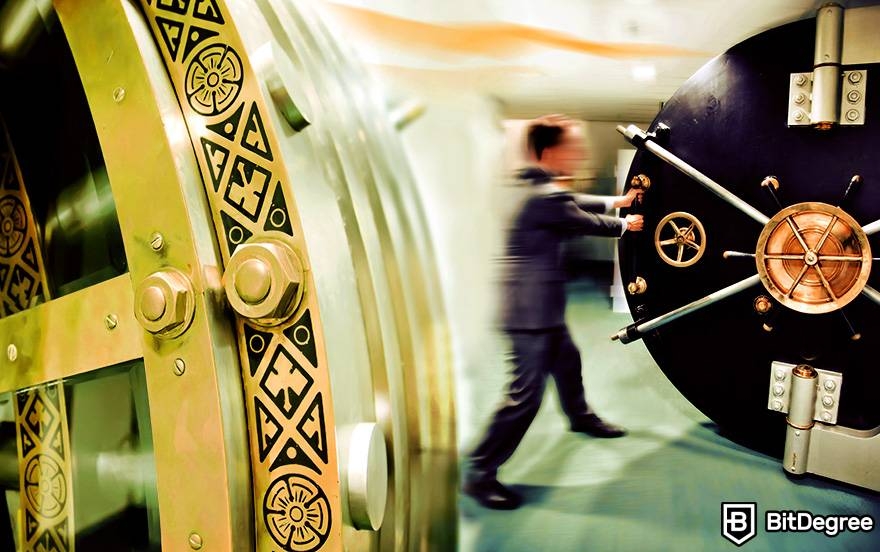
For crypto holders, the most significant threats are network breaches. In general, blockchains tend to be resilient against attacks, employing various multi-level verification processes and relying on mechanisms based on the Byzantine Fault Tolerance (BFT).
However, some parts of decentralized networks, such as bridges that connect two or more blockchains to each other, are more vulnerable to malicious attacks. Additionally, it can be difficult to revert the attacks and reclaim the funds due to on-chain anonymity.

Did you know?
Subscribe - We publish new crypto explainer videos every week!
What is a Crypto Airdrop & How to Get FREE Coins? (Animated)


Storage
When you think about the idea of fiat storage, what comes to your mind first? It's likely to be imagery of wads of money locked in a bank vault deep underground. While that's one of the possibilities, it's not the sole answer to the question – especially when we consider CBDCs.
In general, fiat assets are produced and secured by the central bank of a nation or union (like the Federal Reserve in the US or the European Central Bank for the eurozone members) and distributed to the users (those who use the currency as legal tender) via intermediaries (commercial banks).
Throughout the years, numerous means have been developed to store your personal monetary assets. From keeping money under the bed to locking it in a bank account and accessing it via a debit card – fiat tends to be quite flexible in terms of storage.
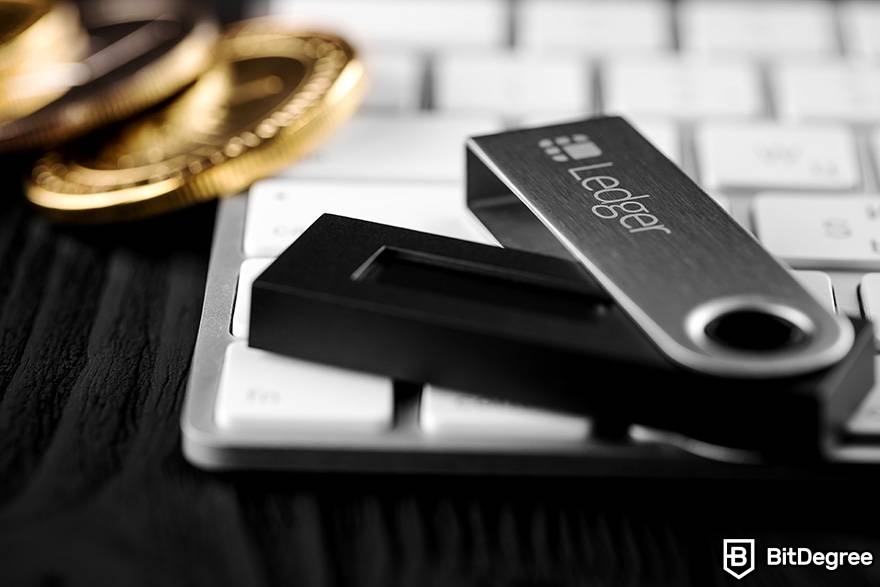
And although cryptocurrencies are digital, there's a decent amount of flexibility in their storage as well. In fact, there are two types of storage units that people tend to think of:
- Hot storage – crypto tools used to store digital assets online, like the Binance Wallet. These include virtual wallets, browser plug-ins, and software. While they are convenient, as all you need is internet access, hot wallets can be more prone to hacker attacks;
- Cold storage – crypto storage units that you possess physically. There's a broad range of tools, including paper wallets, USB sticks, and CDs. However, the most popular are cold wallets, such as Ledger and Trezor. (Technically, you could store your crypto wallet inside your wallet for fiat, too).
If you're converting crypto to fiat, you can typically choose to direct the funds to your preferred digital storage, such as an e-banking account or PayPal. Vice versa, if you're transferring fiat to crypto, you select your preferred wallet address for storage.
Transaction Utility
If you've used crypto as a payment method before, you'll know that there are as many similarities as there are differences compared to fiat. Let's take a look at the utility.
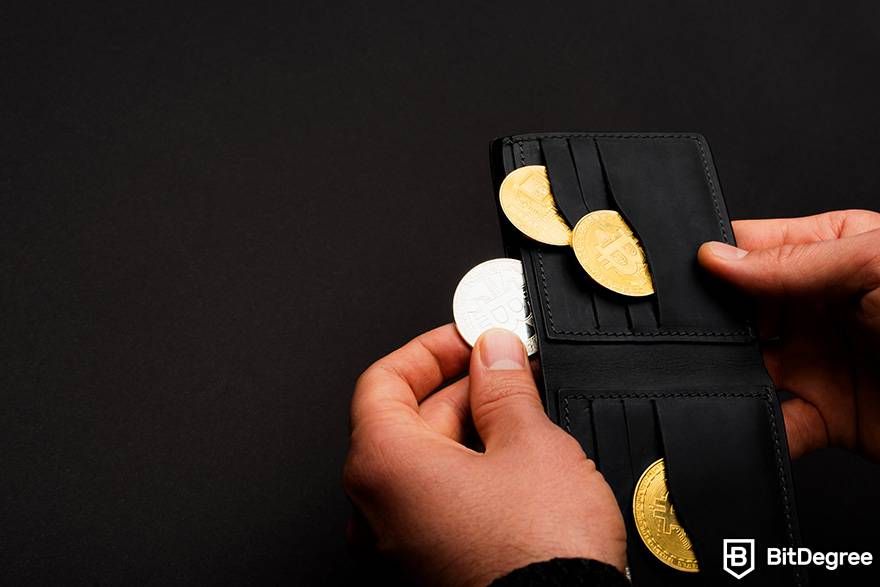
For starters, as you already know, crypto doesn't use intermediaries to conduct transactions. On the other hand, if you want to make a fiat payment using your banking details, it might take hours or even days for it to process due to the bank's operating hours.
That said, fast on-chain transactions aren't always guaranteed. If the network experiences a larger load of transaction requests, it can lead to congestion, which, in turn, ramps up the gas fees. The fluctuating fee rate is a downside compared to more stable fiat transaction costs.
It's also not as easy to get a chargeback if you want to recall your operations on a blockchain. With fiat, you can get in touch with bank representatives to request your money back. However, blockchain is known for its immutability. Once the record is set, it can't be rewritten.
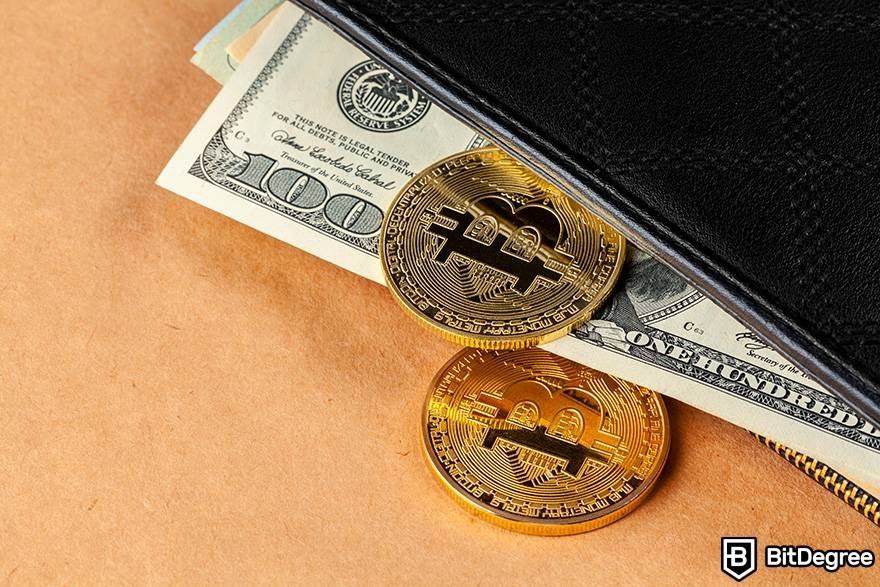
So, as you can see, there are quite a few differences between the two types of assets. Keeping them in mind might help you understand what is fiat in crypto compared to the actual digital assets themselves.
Now that we've covered the key fiat vs crypto differences, here's a quick overview:
| Feature | Fiat | Crypto |
| Format | Physical and digital | Digital |
| Issuance | Governmental institutions | DAOs and blockchain teams |
| Regulation | National and international law | DAOs |
| Volatility | Relatively low | High |
| Inflationary/deflationary | Tends to be somewhat inflationary; possible hyperinflation | Some are developed to be deflationary, others can be inflationary |
| Security | Ensured by the regulatory authorities | Some institutions are audited; bridges are prone to attacks |
| Storage | Bank accounts, physical storage | Hot/cold storage tools & devices |
| Transactions | Refundable; possible delays based on business hours | Non-refundable (blockchain immutability); speeds depend on network congestion |
Table: Fiat vs crypto comparison
Nevertheless, fiat and cryptocurrencies also share some similarities. Both asset types have a community-imposed value and can be used as a medium of exchange. Furthermore, there are instances where the same goods and services can be bought using either fiat or crypto equally.
Crypto-Fiat Conversion
Aside from what is fiat in crypto, traders also need to know how and where it can be used. Crypto regulations are a very complicated topic that we won't be delving into too deeply. Just keep in mind that the utility of fiat in cryptocurrency trading is not universal and differs from platform to platform based on what laws it's subjected to.
Some exchange platforms allow users to convert crypto to fiat and vice versa, while others limit the use of legal tender strictly to purchases. Check out the BitDegree crypto exchanges tracker to find out if your preferred trading platform supports fiat assets and, if so, which ones.
Let's take a look at a practical example and see how to convert crypto to fiat on Binance, one of the biggest centralized exchanges in the world.

- Secure and reliable
- Accepts fiat currencies
- Lots of trading options
- Reputable exchange
- Accepts fiat currencies
- Offers various trading options

- Fiat currencies - accepted
- Simple to use
- Accepts only the most trustworthy cryptocurrencies
- A leading cryptocurrency exchange platform
- Best for beginner investors
- Accepts fiat currencies

- Fully reserved and transparent
- Multiple tradable asset classes
- Over 300 supported cryptos
- Over 300 cryptocurrencies
- Secure & transparent
- Fully reserved
How to Convert Crypto to Fiat on Binance
As a financial asset, fiat is primarily used here for direct conversions and trading. If you want to see what is fiat in crypto used for in practice, this short preview of Binance's services is a good place to start.
Binance is one of the biggest and best-known centralized cryptocurrency exchanges that offers a broad range of services, including cryptocurrency trading and crypto to fiat conversions. You can learn more about Binance on the BitDegree Exchange Tracker.

There are several ways for how to convert crypto to fiat on Binance. The main tools you'll need for any one of them are a Binance account and your fiat banking details (or third-party services like PayPal).
The Binance P2P Trading platform is a peer-to-peer exchange. Here, you can browse user ads and choose which crypto-fiat trades have preferable prices for you. This service is free from additional fees and supports over 300 different payment methods.
Binance also has a designated Buy & Sell platform. You can simply select the amount of crypto that you want to spend, and Binance will automatically calculate the exchange rate for more than 50 fiat currencies based on live data.

Binance Convert is a tool that helps bypass the complicated trading infrastructure. It can be used not just for converting fiat to crypto, but also for exchanging one cryptocurrency for another.
Binance Convert supports two conversion modes – Market and Limit. Market Mode uses the current market price of the quoted currency for the conversion, while Limit Mode allows you to set a price limit to execute the conversion at a suitable rate.
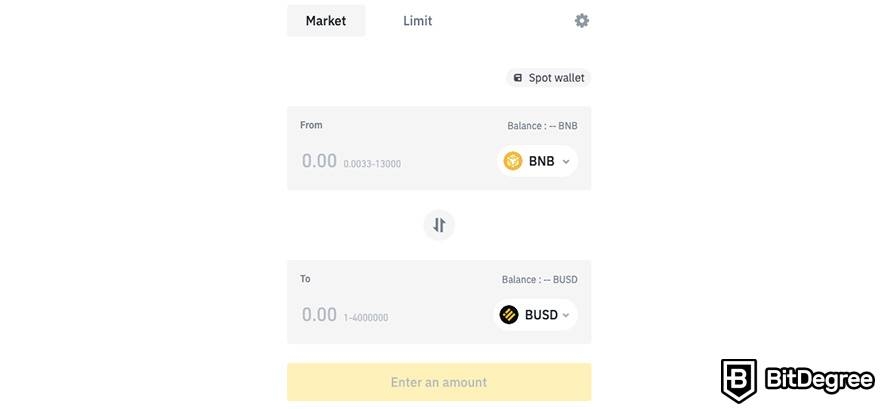
However, if you want to maintain your crypto assets, there's another option you can try – converting your assets to stablecoins. That way, you won't have to worry about fees that you'd be charged for converting crypto to fiat, and the stablecoin would maintain the same value thanks to the peg.
Conclusions
Now that we've answered the big "what is fiat in crypto" question, let's do a quick recap of the key takeaways.
Firstly, fiat refers to currencies that do not have their value tied to commodities. Instead, their value is decided by the common understanding of the community and the government that issues it. Fiat currencies are mainly physical, though projects like CBDCs are in the works.
The crypto fiat meaning is usually used to compare it to cryptocurrencies, or, in some cases, to define stablecoins as digital assets pegged to the value of legal tender. Both fiat and crypto can be used to buy goods and services, and their value is determined the same way – by the communal belief of the society.
While the differences between fiat and crypto are numerous, ranging from how they're issued to what form they take, the overlap between their utility is increasing. It's very possible that soon fiat and crypto will be treated completely equally, not just in the digital space but in the financial landscape as a whole.
So, now whenever someone asks you, "What is fiat in crypto used for?" you should have no trouble explaining the ins and outs of it – or you can simply send them over to this article to learn the essentials themselves.
And if you're new to blockchain-based finance and want to see how to convert crypto to fiat on Binance or vice versa, feel free to follow the steps above. Spoiler alert: it's probably going to be much easier than it seems at first glance.
The content published on this website is not aimed to give any kind of financial, investment, trading, or any other form of advice. BitDegree.org does not endorse or suggest you to buy, sell or hold any kind of cryptocurrency. Before making financial investment decisions, do consult your financial advisor.

